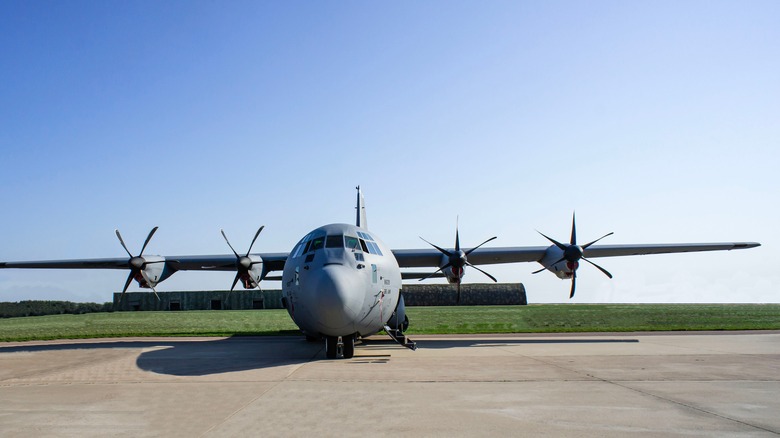Why Does The C-130 Military Transport Plane Use Propellers Instead Of Jet Engines?
Though those who have only flown in the likes of Airbus A320s and Boeing 737s may never have even seen them in action, propellers are still an important part of aviation and have powered (and continue to power) some truly formidable aircraft. The C-130 military transport is just one example.
The C-130 Hercules, as its name suggests, is a hefty, powerful aircraft, had its prototype take its first flight in 1954 and provided the U.S. Armed Forces some crucial versatility. Not only can it pack a significant 44,000 lb payload in its largest variant, but it was also specialized for airlifting purposes, giving it the kind of utility to serve its purpose that aircraft with 132-foot wingspans can't typically muster. It's not as large as the vast C-5M Super Galaxy, but it's an Air Force icon nonetheless, and it's powered by four turboprop engines.
The most notable thing about Lockheed Martin's Hercules, looking at its exterior (aside from its imposing dimensions), is its propellers. These have been a prominent feature since the very first guise of the aircraft, which boasted Curtis-Wright crafted propellers. This is quite an unusual system in an aircraft of its type, but the long-serving Hercules derives some important benefits from it. Let's take a closer look at the engines that power the C-130, how they work, and exactly what the turboprop setup has to offer a machine of this type.
When propellers suit the job best
A turboprop engine will fly more efficiently than an equivalent turbojet engine during slower flights at a lower altitude. A turboprop engine system features propellers, which generate thrust by changing the air flow through their action, which propels the aircraft forward. Conventional jet engines instead produce that thrust through the use of a turbine and compressed air. The compressed air is combined with fuel and introduced to a flame, blasting the aircraft forward as the gas is expelled out of the turbine. The laws of aerodynamics themselves reduce the top speed propeller-driven aircraft can achieve, and their limited relative thrust means that they tend to cruise at lower altitude.
Fuel efficiency, though, is a matter of designing an aircraft to best suit its purpose, to spend as much of its time in the air as possible in its most efficient operating conditions. This, then, is essentially why the Hercules was fitted with turboprops: It isn't a slender and stealthy fighter jet that can scream around at Mach 4 or so for short, fuel-costly bursts, but a workhorse designed for the transport and airdropping of heavy cargo loads across longer distances. Turboprops also have the advantage of lower relative weights and the capacity to use shorter runways, huge boons in aircraft of this size. Fuel costs are a huge concern for aircraft. This is ultimately why the makers of the C-130 Hercules are proponents of the propeller, even with the AC-130 gunship variant.
The C-130 Hercules and its power train
In September 2022, Air Mobility Command was forced to ground a sizable fleet of some C-130H aircraft – an Allison T56-A-15-equipped variant introduced in June of 1974 – when the barrels of its propellers were deemed potentially defective. Nonetheless, overall, the turboprop engines were deemed to be the practical choice for this aircraft family, primarily for reasons of weight and power.
The Hercules was always going to be quite the heavyweight. The C-130J's hefty 164,000 lb max takeoff weight, in combination with its formidable dimensions in any variation, meant that matters of fuel efficiency and performance were paramount. The aforementioned Allison T56 engine offered the primary advantages of being lighter and having a more efficient power output on top of a greater range.
The result of this is a reduction in fuel use and a sign of the virtues that the C-130 would continue to display: In 2014, the C-130H first flew with a quartet of Series 3.5 Rolls-Royce T56 engines. This powertrain, Rolls-Royce boasted, could keep its turbines much cooler and was around 13% more efficient with its fuel use. While fighter jets might use conventional jet engines as they favor speed, turboprop engines aren't as fast (offering around 300 knots less maximum speed relatively) but perform better at lower speeds more suited for carrying heavy loads. The C-130J, the fastest variant, topping out at 417 mph, is a perfect example.


